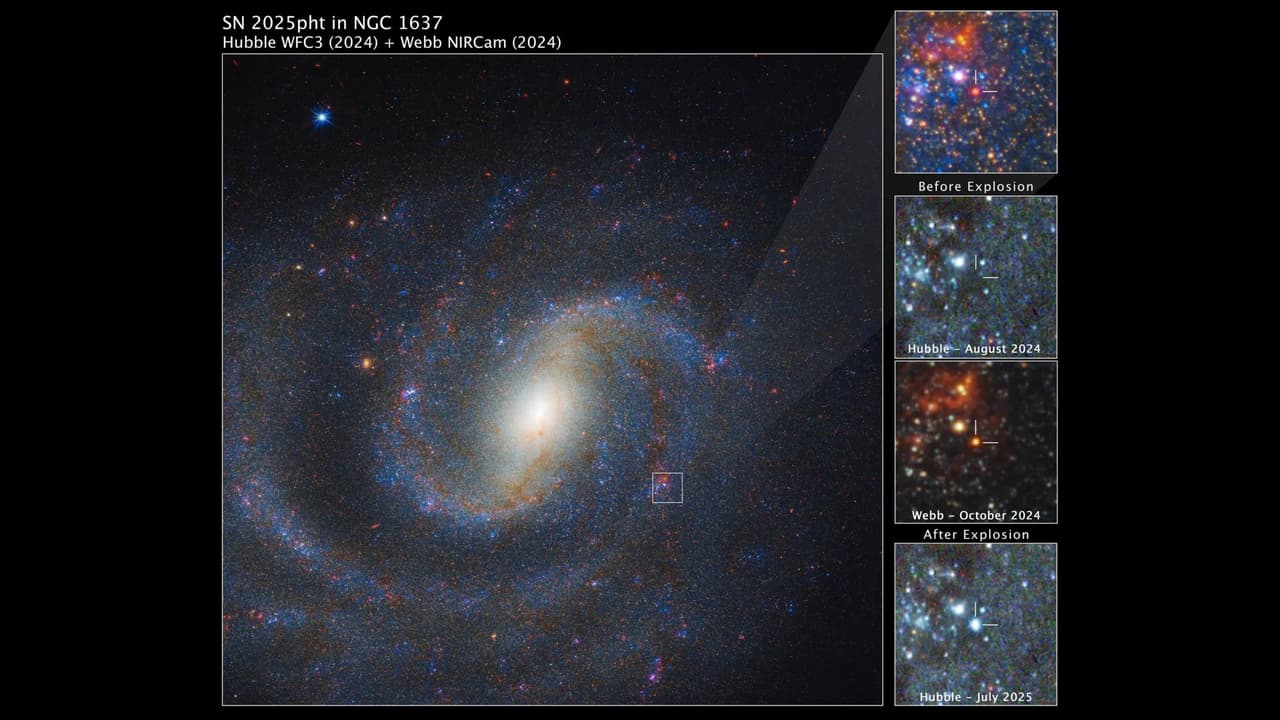Science
JWST Detects Massive Red Supergiant Before Supernova Explosion

NASA’s James Webb Space Telescope (JWST) has made a groundbreaking discovery by detecting a massive red supergiant star just moments before it exploded into a supernova. This observation, made in the spiral galaxy NGC 1637, marks the first direct identification of a progenitor star for a Type II supernova, addressing a long-standing mystery regarding the deaths of massive stars.
The findings were published in The Astrophysical Journal Letters, showcasing the JWST’s ability to penetrate thick layers of dust that previously obscured the star from visible-light telescopes. The doomed star, cataloged as SN2025pht, was identified by a team led by Charlie Kilpatrick from Northwestern University. Their work combined mid-infrared data from JWST with archival images from the Hubble Space Telescope.
Unprecedented Discoveries in Infrared
The research revealed that SN2025pht is the reddest and dustiest red supergiant ever observed before a Type II supernova. Despite emitting approximately 100,000 times more light than the Sun, the star’s thick carbon-rich dust made it appear over 100 times dimmer in visible light. This significant dust presence likely accounts for why many massive stars remain hidden before they explode.
The analysis suggests that, unlike typical red supergiants that produce silicate dust, the dust surrounding SN2025pht is rich in carbon. This indicates that deep convection processes within the star have brought material from its interior to the surface. Such insights into the star’s circumstellar environment provide valuable information about the final stages of massive stars and their eventual explosions.
A New Era for Supernova Research
“This is an exciting time to study massive stars and supernova progenitors,” said Kilpatrick. The advanced infrared capabilities of JWST, paired with future observations from NASA’s Nancy Grace Roman Space Telescope, promise to enhance astronomers’ ability to identify hidden massive stars and monitor their evolution. This research will illuminate the life cycles of the universe’s largest stars, offering a deeper understanding of stellar processes.
The discovery not only bridges the gap between theoretical models and actual observations of stellar deaths but also opens new avenues for cosmic research. As astronomers continue to explore the universe, findings like these will be pivotal in unraveling the mysteries of star formation and destruction.
-

 World5 months ago
World5 months agoSBI Announces QIP Floor Price at ₹811.05 Per Share
-

 Lifestyle5 months ago
Lifestyle5 months agoCept Unveils ₹3.1 Crore Urban Mobility Plan for Sustainable Growth
-

 Science4 months ago
Science4 months agoNew Blood Group Discovered in South Indian Woman at Rotary Centre
-

 World5 months ago
World5 months agoTorrential Rains Cause Flash Flooding in New York and New Jersey
-

 Top Stories5 months ago
Top Stories5 months agoKonkani Cultural Organisation to Host Pearl Jubilee in Abu Dhabi
-

 Sports4 months ago
Sports4 months agoBroad Advocates for Bowling Change Ahead of Final Test Against India
-

 Science5 months ago
Science5 months agoNothing Headphone 1 Review: A Bold Contender in Audio Design
-

 Top Stories5 months ago
Top Stories5 months agoAir India Crash Investigation Highlights Boeing Fuel Switch Concerns
-

 Business5 months ago
Business5 months agoIndian Stock Market Rebounds: Sensex and Nifty Rise After Four-Day Decline
-

 Sports4 months ago
Sports4 months agoCristian Totti Retires at 19: Pressure of Fame Takes Toll
-

 Politics5 months ago
Politics5 months agoAbandoned Doberman Finds New Home After Journey to Prague
-

 Top Stories5 months ago
Top Stories5 months agoPatna Bank Manager Abhishek Varun Found Dead in Well









